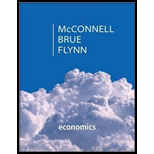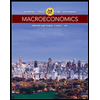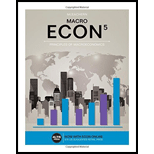
Subpart (a):
Balance sheet .
Subpart (a):
Explanation of Solution
The
The excess reserves are evaluated as follows:
$2,000 is the excess reserve, so the increase in loans is $2,000. Initially, securities and reserves do not change. The people who have borrowed money will have the same amount that will be credited to his or her account for the loan taken, once the loan is made by the bank. So, there will be a rise in checkable deposits for $2,000. Hence, $2000 is the utmost amount of loans that can be made by Big Bucks Bank
Table -1 illustrates the balance sheet of the bank after lending extra money.
Table -1
| Assets | Liabilities and net worth | ||||
(1) |
(1) | ||||
| Reserves | $22,000 | $22,000 | Checkable Deposits | $100,000 | $102,000 |
| Securities | 38,000 | 38,000 | |||
| Loans | 40,000 | 42,000 | |||
Concept Introduction:
Balance sheet: Itis a financial statement that encapsulates organizations’ assets, their liabilities and equity of the shareholders at a particular point in time.
Subpart (b):
Rise in money supply.
Subpart (b):
Explanation of Solution
There is a rise of $2,000 in checkable deposits. A monetary multiplier is not considered till now, so transaction has an immediate effect which is a $2,000 rise in the supply of money.
Subpart (c):
Balance sheet.
Subpart (c):
Explanation of Solution
Table -2 illustrates the new balance sheet.
Table -2
| Assets | Liabilities and net worth | ||||||||||
| (1) | (1) | (2) | |||||||||
| Reserves | $22,00 | $22,000 | $20,000 | Checkable deposits | $100,000 | $102,000 | $100,000 | ||||
| Securities | 38,000 | 38,000 | 38,000 | ||||||||
| Loans | 40,000 | 42,000 | 42,000 | ||||||||
Once the checks against the loan are drawn, there will be a fall of $2,000 in checkable deposits. Once these checks are cleared, the reserves go down by $2,000.
Concept Introduction:
Balance sheet: Itis a financial statement that encapsulates organizations’ assets, their liabilities and equity of the shareholders at a particular point in time.
Subpart (d):
Balance sheet.
Subpart (d):
Explanation of Solution
On the basis of sub part (a), the required reserves are evaluated as follows:
Hence, the required reserves are $15,000.
Excess Reserves are evaluated as follows:
Hence, the excess reserves are $7,000.
$7,000 is the excess reserve, so the increase in loans is $7,000. Initially, securities and reserves do not change. The people who have borrowed money will have the same amount that will be credited to his or her account for the loan taken once the loan is made by the bank. So, there will be a rise in checkable deposits for $7,000.
Table -3 shows the bank’s balance sheet will appear after the bank has lent this additional amount and is obtained from the given diagram.
Table-3
| Assets | Liabilities and net worth | ||||
| (1) | (1) | ||||
| Reserves | $22,000 | $22,000 | Checkable Deposits | $100,000 | $107,000 |
| Securities | 38,000 | 38,000 | |||
| Loans | 40,000 | 47,000 | |||
On the basis of sub part (b), there is a rise of $7,000 in checkable deposits. Monetary multiplier is not considered till now, so the transaction has an immediate effect which is a $7,000 rise in supply of money.
On the basis of sub part (c), once the checks against the loan are drawn, there will be a fall of $7,000 in checkable deposits. Once these checks are cleared, the reserves go down by $7,000.
Table -4 shows the new balance sheet that is illustrated below.
Table -4
| Assets | Liabilities and net worth | ||||||||||
| (1) | (1) | (2) | |||||||||
| Reserves | $22,00 | $22,000 | $20,000 | Checkable deposits | $100,000 | $107,000 | $100,000 | ||||
| Securities | 38,000 | 38,000 | 38,000 | ||||||||
| Loans | 40,000 | 47,000 | 47,000 | ||||||||
Concept Introduction:
Balance sheet: Itis a financial statement that encapsulates organizations’ assets, their liabilities and equity of the shareholders at a particular point in time.
Want to see more full solutions like this?
Chapter 35 Solutions
ECONOMICS W/CONNECT+20 >C<
- Test Preparation QUESTION 2 [20] 2.1 Body Mass Index (BMI) is a summary measure of relative health. It is calculated by dividing an individual's weight (in kilograms) by the square of their height (in meters). A small sample was drawn from the population of UWC students to determine the effect of exercise on BMI score. Given the following table, find the constant and slope parameters of the sample regression function of BMI = f(Weekly exercise hours). Interpret the two estimated parameter values. X (Weekly exercise hours) Y (Body-Mass index) QUESTION 3 2 4 6 8 10 12 41 38 33 27 23 19 Derek investigates the relationship between the days (per year) absent from work (ABSENT) and the number of years taken for the worker to be promoted (PROMOTION). He interviewed a sample of 22 employees in Cape Town to obtain information on ABSENT (X) and PROMOTION (Y), and derived the following: ΣΧ ΣΥ 341 ΣΧΥ 176 ΣΧ 1187 1012 3.1 By using the OLS method, prove that the constant and slope parameters of the…arrow_forwardQUESTION 2 2.1 [30] Mariana, a researcher at the World Health Organisation (WHO), collects information on weekly study hours (HOURS) and blood pressure level when writing a test (BLOOD) from a sample of university students across the country, before running the regression BLOOD = f(STUDY). She collects data from 5 students as listed below: X (STUDY) 2 Y (BLOOD) 4 6 8 10 141 138 133 127 123 2.1.1 By using the OLS method and the information above derive the values for parameters B1 and B2. 2.1.2 Derive the RSS (sum of squares for the residuals). 2.1.3 Hence, calculate ô 2.2 2.3 (6) (3) Further, she replicates her study and collects data from 122 students from a rival university. She derives the residuals followed by computing skewness (S) equals -1.25 and kurtosis (K) equals 8.25 for the rival university data. Conduct the Jacque-Bera test of normality at a = 0.05. (5) Upon tasked with deriving estimates of ẞ1, B2, 82 and the standard errors (SE) of ẞ1 and B₂ for the replicated data.…arrow_forwardIf you were put in charge of ensuring that the mining industry in canada becomes more sustainable over the course of the next decade (2025-2035), how would you approach this? Come up with (at least) one resolution for each of the 4 major types of conflict: social, environmental, economic, and politicalarrow_forward
- How is the mining industry related to other Canadian labour industries? Choose one other industry, (I chose Forestry)and describe how it is related to the mining industry. How do the two industries work together? Do they ever conflict, or do they work well together?arrow_forwardWhat is the primary, secondary, tertiary, and quaternary levels of mining in Canada For each level, describe what types of careers are the most common, and describe what stage your industry’s main resource is in during that stagearrow_forwardHow does the mining industry in canada contribute to the Canadian economy? Describe why your industry is so important to the Canadian economy What would happen if your industry disappeared, or suffered significant layoffs?arrow_forward
- What is already being done to make mining in canada more sustainable? What efforts are being made in order to make mining more sustainable?arrow_forwardWhat are the environmental challenges the canadian mining industry face? Discuss current challenges that mining faces with regard to the environmentarrow_forwardWhat sustainability efforts have been put forth in the mining industry in canada Are your industry’s resources renewable or non-renewable? How do you know? Describe your industry’s reclamation processarrow_forward
- How does oligopolies practice non-price competition in South Africa?arrow_forwardWhat are the advantages and disadvantages of oligopolies on the consumers, businesses and the economy as a whole?arrow_forward1. After the reopening of borders with mainland China following the COVID-19 lockdown, residents living near the border now have the option to shop for food on either side. In Hong Kong, the cost of food is at its listed price, while across the border in mainland China, the price is only half that of Hong Kong's. A recent report indicates a decline in food sales in Hong Kong post-reopening. ** Diagrams need not be to scale; Focus on accurately representing the relevant concepts and relationships rather than the exact proportions. (a) Using a diagram, explain why Hong Kong's food sales might have dropped after the border reopening. Assume that consumers are indifferent between purchasing food in Hong Kong or mainland China, and therefore, their indifference curves have a slope of one like below. Additionally, consider that there are no transport costs and the daily food budget for consumers is identical whether they shop in Hong Kong or mainland China. I 3. 14 (b) In response to the…arrow_forward
 Macroeconomics: Private and Public Choice (MindTa...EconomicsISBN:9781305506756Author:James D. Gwartney, Richard L. Stroup, Russell S. Sobel, David A. MacphersonPublisher:Cengage Learning
Macroeconomics: Private and Public Choice (MindTa...EconomicsISBN:9781305506756Author:James D. Gwartney, Richard L. Stroup, Russell S. Sobel, David A. MacphersonPublisher:Cengage Learning Economics: Private and Public Choice (MindTap Cou...EconomicsISBN:9781305506725Author:James D. Gwartney, Richard L. Stroup, Russell S. Sobel, David A. MacphersonPublisher:Cengage Learning
Economics: Private and Public Choice (MindTap Cou...EconomicsISBN:9781305506725Author:James D. Gwartney, Richard L. Stroup, Russell S. Sobel, David A. MacphersonPublisher:Cengage Learning
 Essentials of Economics (MindTap Course List)EconomicsISBN:9781337091992Author:N. Gregory MankiwPublisher:Cengage Learning
Essentials of Economics (MindTap Course List)EconomicsISBN:9781337091992Author:N. Gregory MankiwPublisher:Cengage Learning Brief Principles of Macroeconomics (MindTap Cours...EconomicsISBN:9781337091985Author:N. Gregory MankiwPublisher:Cengage Learning
Brief Principles of Macroeconomics (MindTap Cours...EconomicsISBN:9781337091985Author:N. Gregory MankiwPublisher:Cengage Learning Principles of Economics (MindTap Course List)EconomicsISBN:9781305585126Author:N. Gregory MankiwPublisher:Cengage Learning
Principles of Economics (MindTap Course List)EconomicsISBN:9781305585126Author:N. Gregory MankiwPublisher:Cengage Learning





